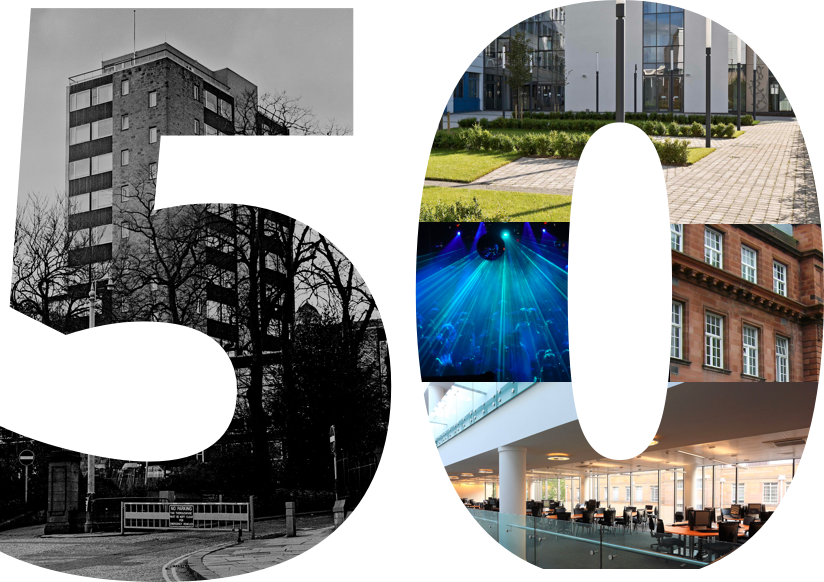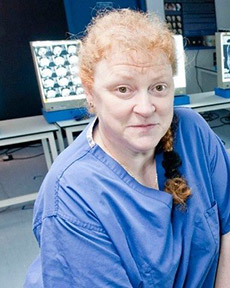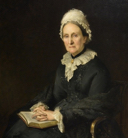
-
Celebrations begin to commemorate 50 years of the University of Dundee
2017 -
The University of Dundee becomes a fully independent institution under the terms of the Royal Charter.
1967 -
Ordinances issued in 1897 made University College form part of St Andrews. and establish a Faculty of Medicine.
1897 -
The Deed formally creating University College Dundee was signed by founders Miss Mary Ann Baxter and her cousin Dr John Boyd Baxter.
1881
Medical Innovations
-
date
Fri, 08 Dec 2017
-
Running Time
00:09:11
Medical research in the modern sense only became possible here thanks to the expansion of Dundee Royal Infirmary in the 1850s.
Episode Transcript
Medical research in the modern sense only became possible here thanks to the expansion of Dundee Royal Infirmary in the 1850s. Perhaps the most notable example of early clinical research was by Thomas Maclagan, who was Medical Superintendent at the Infirmary in the 1860s. During a major fever epidemic, he became one of the first to recognise the clinical value of thermometers, significantly reducing the mortality rate as a result. His most important work, however, was the research he carried out into the anti-rheumatic effects of salicin, a chemical extracted from willow bark. Maclagan's work was taken up by German researchers who used salicin to develop acetyl-salicylic acid - better known today as aspirin. Maclagan later moved to London and established a fashionable practice whose patients included Thomas Carlyle and members of the Royal Family. At the time of his death in 1903, it was said that he "deserves a niche in the Temple of Fame as one of the great benefactors of the human race."
Another new area of research came thanks to the discovery of x-rays in Germany in 1895. Within months of this breakthrough, their possible use in medicine was being investigated by George Pirie at the Dundee Royal Infirmary. He established an Electrical Department there in 1896 and worked there until 1925 when he was forced to retire due to ill-health. His long exposure to x-rays cost him his eyesight and both his hands had to be amputated due to radiation damage.
In a profession dominated by men, some notable women were also medical pioneers in the city, such as Emily Thomson and Alice Moorhead, who became Dundee’s first female GPs at the turn of the century. Best known, however, is Margaret Fairlie, who set up a consultant gynaecological practice in Dundee in 1919, and in the 1920s pioneered the use of radium at Dundee Royal Infirmary following a visit to the Curie Clinic in Paris. You can hear more about her in the podcast, Scientific Women.
There were other notable advances at this time. In the late 1930s, the Professor of Pathology, Dan Cappell, recognised the likelihood of war and had the foresight to set up the Dundee Blood Transfusion Service, which was ahead of any action by the Department of Health and became the model for all the regional services that were hastily formed on the outbreak of hostilities. In the process of setting up the service, Cappell gathered a unique collection of data on the complexities of the newly discovered Rhesus system, ground-breaking research which never received the recognition that it deserved.
After the war, the setting up of the National Health Service had significant impact on the development of medical treatment and research. At the Royal Infirmary, some landmark work was undertaken by consultant radiotherapist James Riley, who set out to investigate the mast cell, whose purpose was then unknown. With the aid of pharmacologist Geoffrey West, he established in 1952 that the mast cell granule was the major source of histamine in the body, making a fundamental contribution to the understanding of inflammatory and allergic reactions.
In 1951, Dundee’s Medical School appointed its first full-time Professors of Medicine and Surgery, Ian Hill and Donald Douglas. Both were leaders in their field, and would later be knighted and become the first-ever Presidents of their respective Edinburgh Colleges from outwith the capital, as well as holding Royal appointments as Physician and Surgeon in Scotland. They collaborated particularly in the care of cardiac patients, placing Dundee at the cutting edge of advances in cardiology.
Dundee also became renowned for its work in orthopaedics. As Professor of Orthopaedic Surgery, Ian Smillie was a world-renowned authority on the surgery of the knee, having previously been based at Bridge of Earn hospital in Perthshire, where he wrote classic books on Injuries of the Knee Joint and Diseases of the Knee Joint and designed his own instruments for menisc ectomies which were then used around the world. His successor George Murdoch founded the Dundee Limb Fitting Centre in Broughty Ferry, opened in 1965 by the legendary amputee air ace Douglas Bader. Its subsequent development as TORT (the Tayside Orthopaedic Rehabilitation Technology Centre, which moved to Ninewells in 1999) has led to international recognition for the treatment of the amputee and assessment of gait analysis.
With new facilities at Ninewells came innovative new teaching methods. Curriculum developments pioneered in Dundee have since been adopted by many other medical schools, most notably the OSCE (or Objective Structured Clinical Examination). This was developed in the mid-1970s as a reliable objective method of measuring clinical skills, removing the ‘luck of the draw’ that had for so long been a bone of contention. Students are presented with a number of situations (exactly the same for each student) and have a fixed amount of time to deal with each one. The system is now used in 40 countries worldwide.
In treatment, Ninewells has also been at the forefront. The first IVF “test-tube” baby in Scotland was born at the hospital in 1984 following the establishment of the Assisted Conception Unit by John Mills and Geoff James.
Most famous, of course, has been the pioneering work led by Sir Alfred Cuschieri in the development, execution and clinical evaluation of minimal access (or laparoscopic) surgery. Prof Cuschieri came to Dundee in 1976, and his surgical techniques have since been adopted internationally. In 1992 he set up the Surgical Skills Unit at Ninewells, now renamed in his honour.
In research, Dundee has become recognised as a world leader. In tackling cancer particularly, there has been significant development since the 1990s with Sir David Lane’s work on the p53 gene and Professor Bob Steele’s leadership of the national bowel cancer screening programme, which has reduced the number of deaths from the UK’s third most common cancer. Dundee researchers have also made great advances in the detection and treatment of kidney, bladder and prostate cancers.
Much of this progress would have been impossible without the help of local residents. The Ninewells Cancer Campaign was started in 1991 spearheaded by Jacqui Wood who worked tirelessly to raise money until her own death from the disease in 2011. To date an amazing £20 million has been raised by the people of Dundee and its surrounding area.
In 2007 the Clinical Research Centre opened at Ninewells as a hub for clinical trial activity, focusing on key research areas such as cancer and cardiovascular disease. The centre has also become renowned internationally for its work in diabetes research, conducting large-scale population studies and using this data to deliver better health outcomes.
These are just some of the recent developments in a long story of medical innovation in Dundee, and many of these stories are told in the displays of the Tayside Medical History Museum at Ninewells, open to the public daily.
Dame Sue Black

Professor Sue Black was born in Inverness and educated at Inverness Royal Academy.
In 1982 she was awarded a Bachelor of Science with Honours in human anatomy from the University of Aberdeen. She later went on to earn her Doctor of Philosophy in human anatomy for her thesis on 'Identification from the human skeleton', also from the University of Aberdeen.
In 1987, she took up the post of lecturer in Anatomy at St Thomas' Hospital, London, starting her career in forensic anthropology, she served in this role until 1992.
Between 1992 and 2003 she undertook various contract work for the United Kingdom's Foreign and Commonwealth Office and the United Nations, involving the identification of victims and perpetrators of various conflicts.
In 1999, she became the lead forensic anthropologist to the British Forensic Team in Kosovo, deployed by the Foreign and Commonwealth Office on behalf of the United Nations.
In 2003 she undertook two tours to Iraq and in 2005 she participated in the United Kingdom's contribution to the Thai Tsunami Victim Identification operation, as part of the 2004 Indian Ocean earthquake and tsunami international response.
In 2003, Black was appointed Professor of Anatomy and Forensic Anthropology at the University of Dundee. In 2008, she was appointed as head of the newly created Centre for Anatomy & Human Identification at the University of Dundee (CAHID).
Professor Black is past President of the British Association of Human Identification (BAHID), and the current President of Association for Science Education (Scotland).
-
Celebrations begin to commemorate 50 years of the University of Dundee
2017 -
The University of Dundee becomes a fully independent institution under the terms of the Royal Charter.
 1967
1967 -
Ordinances issued in 1897 made University College form part of St Andrews. and establish a Faculty of Medicine.
1897 -
The Deed formally creating University College Dundee was signed by founders Miss Mary Ann Baxter and her cousin Dr John Boyd Baxter.
 1881
1881